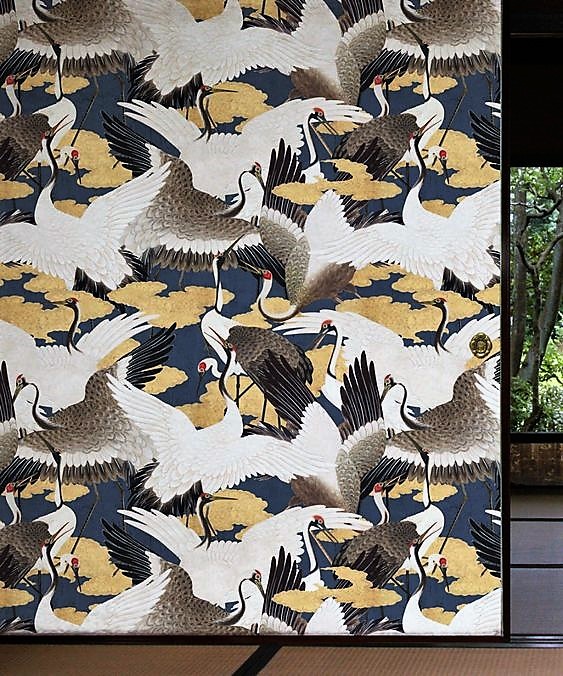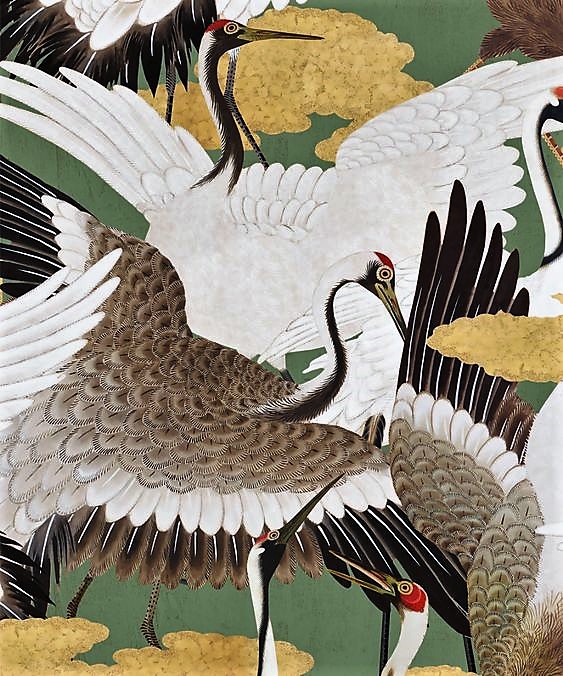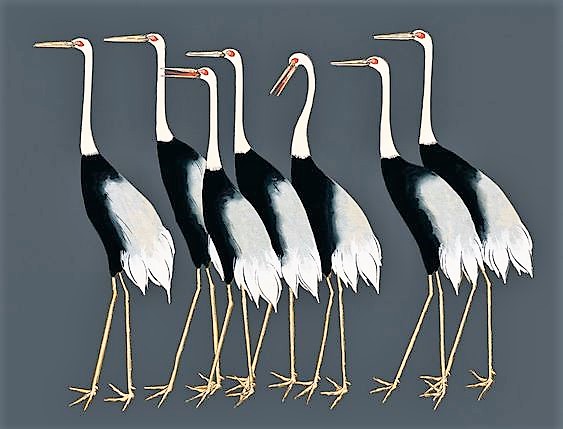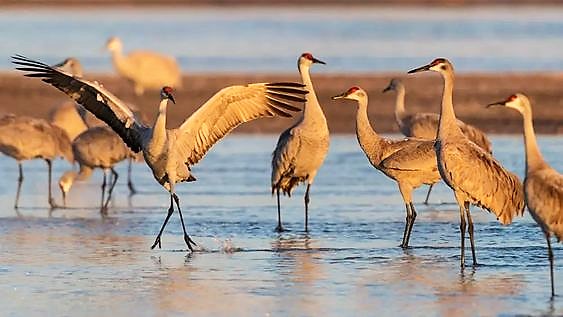
Last Saturday in WEEK ENDNOTES I used this wallpaper to express the confusion I was feeling in my personal life. All that’s evened out now, but still this wallpaper kept showing up in blogs I read and in my Pinterest feed, and it felt disturbing.
When Tuesday an 18-year-old gunman killed 18 fourth-graders and two teachers in a Texas elementary school, I eventually connected the confusion I felt when looking at this wallpaper to the climate of fear caused by our lack of adequate gun laws and gun law enforcement. A stretch, you say? Maybe.

Look closely at the wallpaper, though. It’s a tessellation. That is to say it’s a combination of multiple images that all fit together, like a puzzle, even though we have to keep looking to see the entire picture.

There are the beautiful sandhill cranes, which are the obvious part, and we’re likely mesmerized by their vibrancy, their movement, their grace. Only here they look a bit frantic and frenzied to me, overlapping and crowding each other.

But there’s more to the picture. Look specifically at the negative space–that is, the white, uncolored space between the cranes. There’s another bird there, to be sure, but it’s not a crane. It’s a predatory bird–a hawk or an eagle, both of whom prey on young cranes. These birds of prey look so innocent, clothed in white, and yet they represent death and violence mixed in with vitality and beauty.

Yes, that’s the way of nature. But it isn’t natural that a child who went to school with the expectation of learning and having fun with classmates can’t return home the same day to the comfort and safety of home and family. It’s not natural for the parents who sent that child on its way of a morning to face their child not coming home EVER.
I want to tell you some ‘bedtime’ stories

When my husband and I were elementary school students in the 1960s, we regularly had drills about what to do if the United States was attacked by an atomic bomb. Each year when we moved to a different classroom the route to “shelter” was a little different, and we memorized it and learned to file through the hallways quickly and quietly. We learned also to take shelter under our desks if fleeing wasn’t possible.
My husband remembers not being able to sleep at night if he heard a plane overhead. He would call one of his parents and ask if we were being bombed and whether we should take shelter. But where would that be? Most people in Indiana don’t have basements.
The family across the street from us in New York had not only a basement but a bomb shelter in it, and we would play in it and pretend we were surviving after the bomb. Little did any of us know that had an atomic bomb ACTUALLY been dropped, none of these “precautions” would have saved us from death or radiation sickness that would have led to a more gruesome end.

Fast forward to Dec. 14, 2012, when a 20-year-old shooter killed 20 children and six staff members at Sandy Hook Elementary School in Connecticut. My niece and her husband, both educators, lived and taught 20 minutes away. One of the teachers killed at Sandy Hook had graduated from the school where they worked. “The drills and training we took after Sandy Hook were a lot,” my niece told me. “Sadly [this week] was too much deja vu. I wish this wasn’t a possibility in schools or in our society.”

My hairdresser is 22, born in 2000. As I sat in her chair getting my hair cut Wednesday, she said she never remembers a time in school when they weren’t being trained about what to do in case of a shooter. Because, of course, there was Columbine in 1999, and so many more since. She doesn’t think she should’ve had to experience that fear as a child. She said if she had children now she would home school them purely for safety reasons.
But even then neither the children nor we ourselves would be safe, would we?

I waited in the car in the grocery store parking lot Thursday evening, while my husband went in to pick up a few items. It was taking him longer than expected. I knew there was no trouble because other people were going in and coming out in the usual way. There were no sounds of shots or screams of terror. But still I wondered and looked around.

How can we know when it’s coming?
My hairdresser’s father, she says, carries a gun with him all the time and tells himself it’s so he can defend himself and others if attacked. “But dad,” she told him, “you would already be down before you could react. You’d never see it coming.”
That’s what I thought about as I looked around the parking lot and into the faces of the people wheeling their carts past my car, holding their children’s hands, laughing together.
What about OUR rights?

This is a different wallpaper, a different world. The cranes fly free. The sky is a dark, soft envelope of protection. And it makes me think about those inalienable rights we all should be able to claim:
- The right to sit in my car and not be caught in the crossfire of a shooting and eaten up with fear of shooting.
- The right to see my husband walk back to me from the store unharmed, unafraid, arms full of groceries. The right not to FEAR he won’t.
- The right of children to come home from school at night and sleep peacefully in their beds.
- The right to freedom from the need for “drills” and the fear they cause because the cause of the fear has been dealt with.
- The right of of teachers to teach and not be expected to arm themselves in a futile attempt to head off a shooter.
I say, the hell with the right to own and carry a gun openly. I have–we all have–a larger right to live secure in our homes, our persons and our daily activities WITHOUT guns on the loose.
A story about changing attitudes

My first job out of college was as a reporter on a small daily newspaper in western Ohio. I was assigned to the city beat, and my editor asked me to look out for small, humorous stories that might come out of daily, seemingly run-of-the-mill, police reports.

This week reminded me of one I found and wrote up: A woman in a grocery store notified the manager there was a patron at the meat counter with a gun–this was in the late 1970s, in the days before cell phones. When this man reached across the counter to pick up a package of meat, the woman saw the gun, holstered inside his jacket, and she panicked, as well she might.
The manager immediately called the police, who came out, their own guns drawn, to investigate. What they discovered was that the man with the gun at the meat counter was a fellow policeman in street clothes, paid by the city to carry his gun when off-duty.
Which was as it should be.
It was humorous then, as it should have been. But it’s not so funny now.

I, for one, am STILL alarmed when I see people open-carrying guns in public, but there’s no one I can call for help. How do I tell who plans to “protect” me and who plans to shoot me? A gun on anyone except a police officer makes me feel MORE frightened, not less. It’s much more likely they’ll hurt themselves or someone else–ME or a loved one?–by accident than stop a mass shooting. Why don’t they get that? Are they living in an action film or the wild west?
I want to go to the store and out to eat and NOT see guns tucked into the belts of fellow shoppers and diners. If they’re police officers, that’s okay. THAT makes me feel safe, but not you other guys.
My rights matter, too.
Texas stories

Does anyone else think it’s oddly coincidental (not to mention in poor taste) that the National Rifle Association convened its annual meeting Friday in Houston, TX? Sen. Ted Cruz, R-TX, tweeted “sympathy” to the families of victims of the Tuesday shooting but confirmed he would attend the convention and speak there, as would ex-President Trump.
The Texas governor and lieutenant governor, both NRA members, bowed out of planned appearances at the convention out of respect for the families of victims. However, the governor blamed the shooting on a “mental health challenge” and said the state needed to “do a better job with mental health,” even though in April he slashed $211 million from the department that oversees mental health programs.
It’s duplicitous to express sympathy for someone over something you could prevent and won’t.

Did I mention my niece and her husband live and teach in Texas now? It’s deja vu all over again. I feel for them. I feel for the stress all teachers must feel and all parents of schoolchildren.
I’ve been a public school teacher. I worked hard, I wasn’t paid well, and I certainly wouldn’t have wanted anyone to expect me to take up arms as part of my job. It was hard enough just getting through some days when the only violence I had to be wary of was possible backlash when I sent an uncooperative student to the principal’s office. That was bad enough, believe me.
Lessons from Antigone and the cranes

Sandhill cranes interestingly are assigned to the genus Antigone. You remember her, don’t you? Sophocles wrote about her some 2,500 years ago. Her brothers killed each other in a fight for the kingship of Thebes, and their uncle, who inherited the throne because of their deaths, buried one but not the other. Antigone buried him anyway. Her name means in place of a mother.

The three siblings were the children of Oedipus and Jocasta (Oedipus who married his mother unknowingly). Upon his death, their father decreed the sons would alternate years reigning over Thebes, but the elder, after his year, refused to step down. Both sons died in the squabble, but the younger one, who should have been allowed to take the throne, was the one disgraced and left unburied by their Uncle Creon, the usurper.
To add insult to injury, Creon insisted Antigone marry HIS son, which would help solidify his power. Although Antigone planned to marry Creon’s son anyway and loved him, she then refused because of what Creon had done. Creon’s wife, Eurydice, during all the commotion, did nothing but knit and hide in her room.

The story does not end well, as you can imagine from all Greek tragedy. but it does have some interesting parallels to today. We all know who the brother who wouldn’t leave office is, as well as the Creons who honor him and not the rightful leader. And who among us hasn’t been Eurydice, pretending not to see? Our dilemma will not end well either, unless we pay some serious attention to it.
Sen. Chris Murphy, D-CT, asked the question on everyone’s lips:
It’s time now to do the something we all can do. (And it doesn’t involve arming ourselves MORE.)

We owe it to the earth. We owe it to the children.

